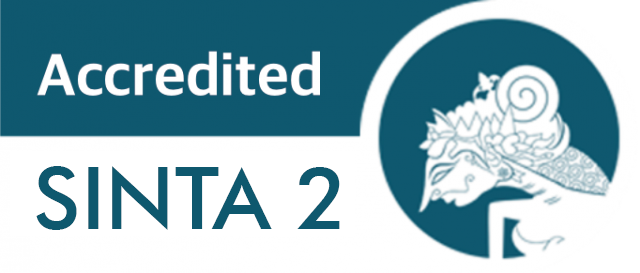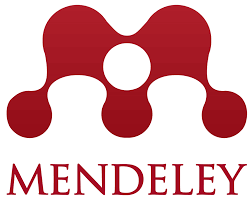Integrating Science and Islam: Development of Teaching Materials for Environmental Chemistry Courses
DOI:
https://doi.org/10.15408/tjems.v10i2.32210Keywords:
teaching materials, Islamic integrated chemistry, environmental chemistry, bahan ajar, kimia terintegrasi keislaman, kimia lingkunganAbstract
Abstract
The teaching materials on chemistry integrated into Islam are not yet available at the university level. Teaching materials can be used in learning activities. This study aims to develop integrated Islamic chemistry teaching materials for environmental chemistry courses. This research uses the Four Steps Material Teaching Development method (4STMD). 4STMD consists of four stages, namely the selection stage, structuring stage, characterisation stage, and reduction stage. At the stage of selection and structuring, the results of integration between environmental chemistry subjects and the Qur’an, Hadith, Fiqih, and Aqeedah Morals are obtained. At the characterisation stage, the concepts tested have easy characteristics, with an overall score of 86.9%. Based on the characterisation test results, the reduction phase in this research was not carried out because all concepts have easy characteristics. The completed teaching materials are then tested for feasibility by experts based on material aspects, presentation, language, and graphics. Based on the results of the feasibility test of the teaching materials, the average score is 95%. This shows that the teaching materials are considered worthy with a ‘very good’ predicate.
Abstrak
Bahan ajar kimia terintegrasi keislaman belum tersedia di tingkat Universitas. Bahan ajar dapat digunakan dalam kegiatan pembelajaran. Penelitian ini bertujuan untuk mengembangkan bahan ajar kimia terintegrasi keislaman pada Mata Kuliah Kimia Lingkungan. Penelitian ini menggunakan metode Four Steps Teaching Material Development (4STMD). 4STMD terdiri dari empat tahapan, yaitu tahap seleksi, tahap strukturisasi, tahap karakterisasi, dan tahap reduksi. Pada tahap seleksi dan strukturisasi, didapatkan hasil integrasi antara mata kuliah kimia lingkungan dengan Al Qur’an, Hadits, Fikih, dan Akidah Akhlak. Pada tahap karakterisasi, keseluruhan konsep yang diujikan memiliki karakteristik mudah, dengan nilai keseluruhan rata-rata sebesar 86,9%. Berdasarkan hasil uji karakterisasi, tahap reduksi pada penelitian ini tidak dilakukan karena seluruh konsep memiliki karakteristik mudah. Bahan ajar yang telah selesai disusun selanjutnya di uji kelayakannya oleh ahli berdasarkan aspek materi, penyajian, bahasa, dan grafika. Berdasarkan hasil uji kelayakan bahan ajar, didapatkan nilai rata-rata sebesar 95%. Hal ini menunjukkan bahwa bahan ajar dinyatakan layak dengan predikat sangat baik.
How to Cite: Muslim, B., Nahadi, Anwar, S., Munawaroh, H.S.H., & Nuraeni, N.S (2023). Integrating Science and Islam : Development of Teaching Materials for Environmental Chemistry Courses. TARBIYA: Journal of Education in Muslim Society, 10(2), 207-218. doi:10.15408/tjems.v10i2.32210.
References
Abdulsalam Sulaiman Dawood Al-Hadab. (2018). Integrating the Qur’n Verses into Secondary School Science Curriculum of Yemen: An Islamic Perspective.
Al-hadabi, A. S. D. (2016). Integrating the Qur ’ n Verses into Secondary School Science Curriculum of Yemen : An Islamic Perspective. International Journal of Humanities and Social Science Research, 2, 37–48.
AlJuwaie, G. F., Latif, R., AlSheikh, M. H., Al Sunni, A., & Chathoth, S. (2020). Effects of Zamzam water on glycemic status, lipid profile, redox homeostasis, and body composition in rats. Journal of Taibah University Medical Sciences, 15(1), 14–18. https://doi.org/10.1016/j.jtumed.2019.12.008
Anas, N., Alwi, E. A. Z., Razali, M. H. H., Subki, R. N., & Bakar, A. N. A. (2013). The Integration of Knowledge in Islam : Concept and Challenges. Global Journal Of Human Social Science Linguistics & Education, 13(10), 50–55.
Aqsha, M., Ramlee, L., Abdullah, M., & Lampoh, A. (2009). Integrated Islamic Education in Brunei Darussalam: Philosophical Issues and Challenges. Journal of Islamic and Arabic Education, 1(2), 51–60.
Arifin, & Sjaeful, A. (2016). The Development Of Air-Theme Integrated Science Teaching Material Using Four Steps Teaching Material Development. Jurnal Pendidikan Fisika Indonesia, 12(1), 8–18. https://doi.org/10.15294/jpfi
Arip Kasmo, M., Hamdi Usman, A., Haron, H., Salam Yusuf, A., Idris, F., Yunos, N., & Abd Khafidz, H. (2015). The compatibility between the Quran and modern science: A comparative study among Malaysian. Asian Social Science, 11(10), 299–306. https://doi.org/10.5539/ass.v11n10p299
Ashri, N., & Hasanah, L. (2016). Uji Keterpahaman Dan Kelayakan Bahan Ajar Ipa Terpadu. EDUSAINS, 8(2), 145–149.
Ashtankar, O. M. (2016). Islamic perspectives on environmental protection. International Journal of Applied Research, 2(1), 438–441.
Didik Kurniawan, Jaenullah, Siti Roudhotul Jannah, Dedi Setiawan, M. (2023). Strategy For Increasing The Learning Qur’an Hadits Quality For The Students’ Religious Character. Jurnal As-Salam 7(1), 57–71.
Donia, A. F., & Mortada, W. I. (2021). Chemical composition of Zamzam water: A comparative study with international standards of drinking water. Heliyon, 7(1), e06038. https://doi.org/10.1016/j.heliyon.2021.e06038
El-Seedi, H. R., Khalifa, S. A. M., Yosri, N., Khatib, A., Chen, L., Saeed, A., Efferth, T., & Verpoorte, R. (2019). Plants mentioned in the Islamic Scriptures (Holy Qur’ân and Ahadith): Traditional uses and medicinal importance in contemporary times. Journal of Ethnopharmacology, 243(June), 112007. https://doi.org/10.1016/j.jep.2019.112007
Fahyuni, E. F., Wasis, Bandono, A., & Arifin, M. B. U. B. (2020). Integrating islamic values and science for millennial students’ learning on using seamless mobile media. Jurnal Pendidikan IPA Indonesia, 9(2), 231–240. https://doi.org/10.15294/jpii.v9i2.23209
Fauzan. (2017). Integrasi Islam dan Sains dalam Kurikulum Program Studi Pendidikan Guru MI Berbasis KKNI. Journal of Madrsah Ibtidaiyah Education, 1–13.
Fitriani, F., Mahmud, & Darmana, A. (2016). Pengembangan dan Standarisasi Bahan Ajar Kimia Terintegrasi Nilai-Nilai Spiritual Untuk Kelas XI SMA / MA Semester 1 Berdasarkan Badan Standar Nasional Pendidikan. Jurnal Pendidikan Kimia, 8(1), 12–18.
Freitas, M., Correa, M., & Freitas, S. (2018). Science, Religion and Amazonia: Education for Sustainability. Of Environmental & Science June. https://www.researchgate.net/profile/Marcilio-Freitas-2/publication/328347230_Science_Religion_and_Amazonia_Education_for_Sustainability/links/5bc7cf2da6fdcc03c78eece9/Science-Religion-and-Amazonia-Education-for-Sustainability.pdf
Hamzah, F. (2015). Studi Pengembangan Modul Pembelajaran IPA berbasis Intregrasi Islam-Sains Pada Pokok Bahasan Sistem Reproduksi Kelas IX madrasah Tsanawiyah. Jurnal Pendidikan Islam, 1(1), 41–54.
Hashim, R., & Abdallah, S. S. (2013). Islamization of Human Knowledge in Theory and Practice: Achievements, Challenges and Prospects in the IIUM context Rosnani Hashim & Ssekamanya Siraje Abdallah Institute of Education, International Islamic University Malaysia (IIUM). IIUM Journal of Educational Studies, 1(1), 1–11.
Hendri, S., & Setiawan, W. (2016). the Development of Earth Quake Teaching Material for Junior High School By Four Step Teaching Materials Development Method Pengembangan Bahan Ajar Tema Gempa Bumi Menggunakan Four Step Teaching Materials Development. 12(1), 65–76. https://doi.org/10.15294/jpfi
Herron, J. D., Cantu, L. L., Ward, R., & Srinivasan, V. (1977). Problems associated with concept analysis. Science Education. https://doi.org/10.1002/sce.3730610210
Izhar Ariff Mohd Kashim, M., Abdul Haris, A. A., Abd. Mutalib, S., Anuar, N., & Shahimi, S. (2023). Scientific and Islamic perspectives in relation to the Halal status of cultured meat. Saudi Journal of Biological Sciences, 30(1), 103501. https://doi.org/10.1016/j.sjbs.2022.103501
Khalid, H., Norfaiza, F., Hasan, A., Rosman, A. S., & Khan, A. (2022). The Intergration Of Science And Islam In Malaysia Of High Education Instituts: An Explorative Survey. Journal of Positive School Psychology, 6(3), 2186–2199.
Lubis, M. A. (2015). Effective implementation of the integrated Islamic education. Global Journal Al-Thaqafah, 5(1), 59–68. https://doi.org/10.7187/gjat792015.05.01
Manoiu, V., Düzgüneş, E., Azzeddine, M., & Manoiu, V.-S. (2016). A Qualitative Exploration Of The Holy Quran’s Environmental Teachings. International E-Journal of Advances in Education, 2(5), 209–217.
Marfu’ah, S., & Anwar, S. (2018). How to develop SETS-based colloidal system teaching materials? International Conference on Mathematics and Science Education, 3, 298–303.
Munadi, M. (2016). Integration of Islam and Science: Study of Two Science Pesantrens (Trensain) in Jombang and Sragen. Jurnal Pendidikan Islam, 5(2), 287. https://doi.org/10.14421/jpi.2016.52.287-303
Munasprianto Ramli, Buchori Muslim, S. N. F. (2019). Integrasi Pencemaran Logam Berat Dan Islam Menggunakan Metode 4-Stmd. Jurnal As-Salam 3(3), 102–115.
Muslim, B. (2016). Kimia Dalam Perspektif Islam. Proceeding Seminar & Bedah Buku “ Islam Dan Sains : Upaya Pengintegrasian Islam Dan Ilmu Pengetahuan Di Indonesia ,” 138–149.
Muslim, B., Ramli, M., & Nursarifah, U. (2021). Pengembangan Video Animasi Kimia Terintegrasi Keislaman pada Materi Struktur Atom. Jambura Journal of Educational Chemistry, 3(2), 47–52. https://doi.org/10.34312/jjec.v3i2.11568
Mustafa, Z., Baharuddin, A., & Saifuddeen, S. M. (2021). Islam, Science and Education: Delving into the Progress, Collaboration and Biases. Journal of Islamic Thought and Civilization, 11(2), 44–68. https://doi.org/10.32350/jitc.11.2.03
Nadila, S., Joewono, H. T., & Sulistyono, A. (2022). Murottal Sura Al-Fatiha during pregnancy increased the number of neuron cells in the cerebrum and cerebellum of the newborn Rattus Norvegicus. International Journal of Health Sciences, 6(3), 1383–1390. https://doi.org/10.53730/ijhs.v6n3.12734
Novak, J. D., & Cañas, A. J. (2008). The Theory Underlying Concept Maps and How to Construct and Use Them. 1–36.
Nusnowati. (2012). Pengembangan Perkuliahan Kimia Lingkungan Berbasis Masalah Untuk Meningkatkan Nilai-Nilai Karakter Mahasiswa. Lembaran Ilmu Kependidikan, 41(2), 109–113.
Perbukuan, P. K. dan. (2014). Pedoman Penilaian Buku Nonteks Pelajaran (Issue 2).
Standar Nasional Pendidikan Tinggi, (2015).
Rachmatullah, A., Park, S., & Ha, M. (2022). Crossing borders between science and religion: Muslim Indonesian biology teachers’ perceptions of teaching the theory of evolution. In Cultural Studies of Science Education (Vol. 17, Issue 2). Springer Netherlands. https://doi.org/10.1007/s11422-021-10066-4
Ramli, M. (2014). Integrasi Pendidikan Agama Islamke Dalam Mata Pelajaran Ilmu Pengetahuan Alam di Madrasah Tsanawiyah Negeri Mulawarman Banjarmasin. Ittihad Jurnal Kopertais Wilayah XI Kalimantan, 12(21), 111–132.
Rasyid, S., Nurdin, D., Suryana, A., Samsudin, A., & Aminudin, A. H. (2022). Can the tahfidzul-qur’an education system (T-QES) create leadership with integrity? NVivo 12 analysis. Cypriot Journal of Educational Sciences, 17(6), 1925–1942. https://doi.org/10.18844/cjes.v17i6.7485
Rifai, N., Fauzan, Sayuti, W., & Bahrissalim. (2014). Integrasi keilmuan dalam pengembangan kurikulum di uin se-indonesia: Tarbiya, 1(1), 13–34.
Safkolam, R., Khumwong, P., Pruekpramool, C., & Hajisamoh, A. (2021). Effects of islamic scientist history on seventh graders’ understandings of nature of science in a thai islamic private school. Jurnal Pendidikan IPA Indonesia, 10(2), 282–291. https://doi.org/10.15294/jpii.v10i2.26668
Silaban, R., Septiani, B., & Hutabarat, W. (2015). Penyusunan Bahan Ajar Kimia Inovatif Materi Laju Reaksi Terintegrasi Pendidikan Karakter Siswa SMA. Jurnal Tabularasa PPS UNIMED, 12(1), 78–88.
Suciati, R., Susilo, H., Gofur, A., Lestari, U., & Rohman, I. (2022). Millennial students’ perception on the integration of Islam and science in Islamic universities. Indonesian Journal of Islam and Muslim Societies, 12(1), 31–57. https://doi.org/10.18326/ijims.v12i1.31-57
Suyadi, & Widodo, H. (2019). Millennialization of islamic education based on neuroscience in the third generation university in yogyakarta Indonesia. Qudus International Journal of Islamic Studies, 7(1), 173–202. https://doi.org/10.21043/qijis.v7i1.4922
Sistem Pendidikan Nasional, 1.
Muslim, B., Nahadi, Anwar, S., (2023). Integration Science And Islam : A New Product To Facilitate Teaching and Learning in College. Jurnal As-Salam 7(2), 215–230.
Woodford, P. J. (2020). Philosophy in the science classroom: How should biology teachers explain the relationship between science and religion to students? Cultural Studies of Science Education, 15(4), 937–950. https://doi.org/10.1007/s11422-020-09997-1
Yani, A. P., & Joewono, H. T. (2021). Effect of Murotal Sound Stimulation during Pregnancy on the Number of Neuron Cells of Cerebrum and Cerebellum of the Newborn Rattus norvegicus. Indian Journal of Forensic Medicine & Toxicology, 15(4), 845–851. https://doi.org/10.37506/ijfmt.v15i4.16809
Zain, S., Ahmad, Z., Ismail, A. F., Salah, M., & Mohamad, S. A. (2016). Development of integrated science textbooks by applying the enrich tool. Journal of Education and Social Sciences, 5(2011), 6–13.











